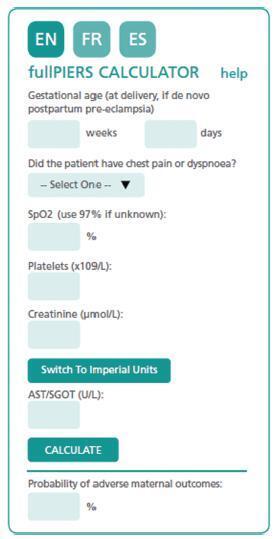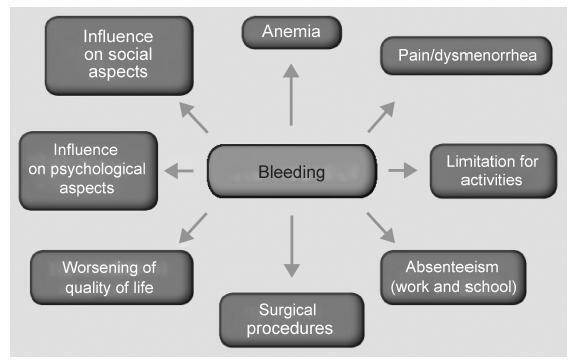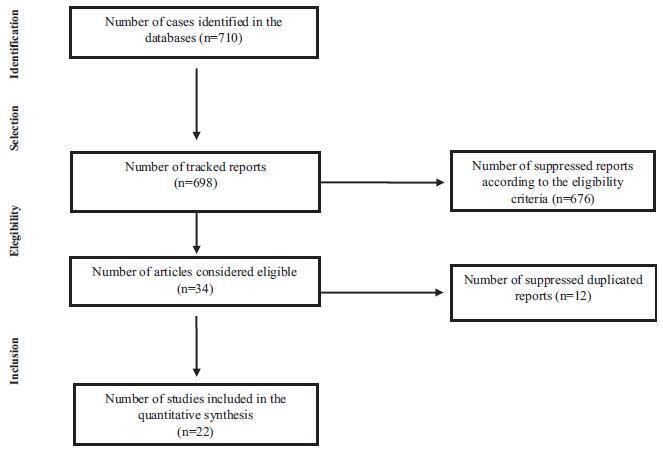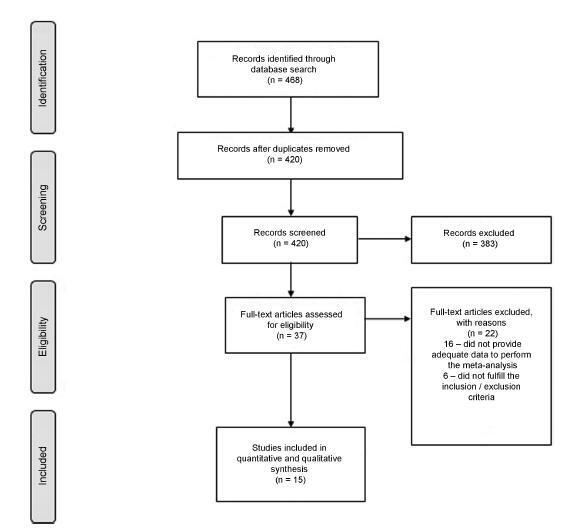-
Review Article
Acute Onset Neurological Disorders during Pregnancy: A Literature Review
Revista Brasileira de Ginecologia e Obstetrícia. 2017;39(10):560-568
10-01-2017
Summary
Review ArticleAcute Onset Neurological Disorders during Pregnancy: A Literature Review
Revista Brasileira de Ginecologia e Obstetrícia. 2017;39(10):560-568
10-01-2017Views112Abstract
Objectives
To characterize the most common peripheral and central neurological disorders during pregnancy.
Methods
Original research and review of the literature on neurological complications during pregnancy. We searched for keywords related to the topic on different databases.
Results
Pregnancy involves physiological changes that can trigger peripheral neurological and/or central nervous system pathologies, which can sometimes be associated with hypertensive disorders. A definitive diagnosis of neurological disorders can be made according to the trimester of pregnancy and the clinical findings. Carpal tunnel syndrome and peripheral facial palsy are common peripheral neurological disorders, more frequent in the second half of pregnancy. Central nervous disorders are more complex and a precise diagnosis must be made in order to improve perinatal outcomes, provide correct management and treatment and to prevent acute and long-term complications.
Conclusions
It is possible to achieve a precise diagnosis,management and treatment of neurological disorders during pregnancy, but these require a multidisciplinary approach, crucial to improve perinatal outcomes.
Key-words Bell’s palsycarpal tunnel syndromecerebrovascular complicationsHeadachemanagementPregnancySee more
-
Review Article
Preeclampsia
Revista Brasileira de Ginecologia e Obstetrícia. 2017;39(9):496-512
09-01-2017
Summary
Review ArticlePreeclampsia
Revista Brasileira de Ginecologia e Obstetrícia. 2017;39(9):496-512
09-01-2017Views426Abstract
The authors review hypertensive disease during pregnancy with an academic and practical view, and using the best evidence available. This disease, which is the most important clinical disease in Brazilian pregnant women, may have its incidence reduced with prevention through the use of calcium and aspirin in pregnant women at risk. Previously, it was a disease that presented with hypertension with proteinuria, but it has now been classified with new clinical parameters besides proteinuria. Morbidity and mortality should be reduced in a continental country such as Brazil using protocols for the early treatment of complications by calculating severe outcomes in preeclampsia. The early treatment of acute hypertension, use of magnesium sulfate and early hospitalization in cases of preeclampsia are concepts to pursue the reduction of our pregnant women’s mortality.
Key-words HELLP syndromeHigh risk pregnancyPreeclampsiapregnancy arterial hypertensionPregnancy complicationsSee more
-
Review Article
Physical Activity during Pregnancy: Recommendations and Assessment Tools
Revista Brasileira de Ginecologia e Obstetrícia. 2017;39(8):424-432
08-01-2017
Summary
Review ArticlePhysical Activity during Pregnancy: Recommendations and Assessment Tools
Revista Brasileira de Ginecologia e Obstetrícia. 2017;39(8):424-432
08-01-2017Views201See moreAbstract
The literature that supports and recommends the practice of exercise during pregnancy is extensive.However, although a more complete research on ways to evaluate the physical activity performedby pregnant women has been perfomed, it is found that there is no gold standard and that the articles in the area are inconclusive. Thus, the objective of the present article is to review relevant aspects, such as, technique and applicability of the different methods for the assessment of physical activity during pregnancy to providemore reliable and safe information for health professionals to encourage their pregnant patients to engage in the practice of physical activity. This review concluded that all tools for the analysis of physical activity have limitations. Thus, it is necessary to establish the objectives of evaluation in an appropriate manner, as well as to determine their viability and costeffectiveness for the population under study.
-
Review Article
Abnormal Uterine Bleeding
Revista Brasileira de Ginecologia e Obstetrícia. 2017;39(7):358-368
07-01-2017
Summary
Review ArticleAbnormal Uterine Bleeding
Revista Brasileira de Ginecologia e Obstetrícia. 2017;39(7):358-368
07-01-2017Views256Abstract
Abnormal uterine bleeding is a frequent condition in Gynecology. It may impact physical, emotional sexual and professional aspects of the lives of women, impairing their quality of life. In cases of acute and severe bleeding, women may need urgent treatment with volumetric replacement and prescription of hemostatic substances. In some specific cases with more intense and prolonged bleeding, surgical treatment may be necessary. The objective of this chapter is to describe the main evidence on the treatment of women with abnormaluterinebleeding, both acuteand chronic.Didactically,thetreatmentoptions were based on the current International Federation of Gynecology and Obstetrics (FIGO) classification system (PALM-COEIN). The etiologies of PALM-COEIN are: uterine Polyp (P), Adenomyosis (A), Leiomyoma (L), precursor and Malignant lesions of the uterine body (M), Coagulopathies (C), Ovulatory dysfunction (O), Endometrial dysfunction (E), Iatrogenic (I), and Not yet classified (N). The articles were selected according to the recommendation grades of the PubMed, Cochrane and Embase databases, and those in which the main objective was the reduction of uterine menstrual bleeding were included. Only studies written in English were included. All editorial or complete papers that were not consistent with abnormal uterine bleeding, or studies in animal models, were excluded. The main objective of the treatment is the reduction of menstrual flow and morbidity and the improvement of quality of life. It is important to emphasize that the treatment in the acute phase aims to hemodynamically stabilize the patient and stop excessive bleeding, while the treatment in the chronic phase is based on correcting menstrual dysfunction according to its etiology and clinical manifestations. The treatment may be surgical or pharmacological, and thelatterisbasedmainlyonhormonaltherapy,anti-inflammatorydrugsandantifibrinolytics.
Key-words Abnormal uterine bleedingdysfunctional uterine bleedingheavy menstrual bleedingmenorrhagiaPALM-COEINSee more
-
Review Article
Are There Changes in the Fatty Acid Profile of Breast Milk with Supplementation of Omega-3 Sources? A Systematic Review
Revista Brasileira de Ginecologia e Obstetrícia. 2017;39(3):128-141
03-01-2017
Summary
Review ArticleAre There Changes in the Fatty Acid Profile of Breast Milk with Supplementation of Omega-3 Sources? A Systematic Review
Revista Brasileira de Ginecologia e Obstetrícia. 2017;39(3):128-141
03-01-2017Views162See moreAbstract
Purpose
To evaluate the effect of supplementation with omega-3 sources on the fatty acid composition of human milk.
Methods
The review consisted of the search for articles published in PubMed, Biblioteca Virtual de Saúde (Virtual Health Library[VHL]) andWeb of Science databases using the following keywords: fatty acids, omega-3, human milk and supplementation; for this purpose, we have used the program of research to integrate the services for the maintenance of autonomy (PRISMA) checklist. The following selection criteria were used: articles in English, Portuguese, Spanish or Italian, published between 2000 and 2015, and about studies performed in humans. We found 710 articles that met the established criteria; however, only 22 of them were selected to be part of this study.
Results
All studies found a positive relationship between the consumption of omega- 3 sources and their concentration in humanmilk. The differences in the findings are due to the distinct methods used, such as the specific time of the omega-3 supplementation, the type of omega-3 source offered, as well as the sample size.
Conclusion
Although the studies were different in several methodological aspects, it was possible to observe the importance of omega-3 supplementation during gestation and/or the puerperium.

-
Review Article
Multidisciplinary Approach to Neoadjuvant Endocrine Therapy in Breast Cancer: A Comprehensive Review
Revista Brasileira de Ginecologia e Obstetrícia. 2016;38(12):615-622
12-01-2016
Summary
Review ArticleMultidisciplinary Approach to Neoadjuvant Endocrine Therapy in Breast Cancer: A Comprehensive Review
Revista Brasileira de Ginecologia e Obstetrícia. 2016;38(12):615-622
12-01-2016Views101See moreABSTRACT
Breast cancer is the most common type of cancer and the leading cause of cancer-related death among women worldwide. Hormone receptor-positive (HRþ) tumors represent the most common form of this disease, with more than 70% of breast cancers expressing these receptors. Response and benefit to neoadjuvant chemo-therapy (NCT) varies according to HR expression, with lower responses in luminal tumors as compared with hormone receptor-negative (HR-) and human epidermal growth factor receptor 2-positive (HER2þ) tumors. Neoadjuvant endocrine therapy (NET) is an option for selected patients with HRþ locally advanced breast cancer. Neoadjuvant endocrine therapy has a favorable toxicity profile, and is associated with benefits such as having low cost and being more easily available even for cancer care professionals outside major urban areas or tertiary centers. These factors are particularly relevant, as 70% of breast cancer deaths occur in women from low-income and middle-income countries. Additionally, NET is being increasingly explored, not simply to allow for less extensive surgery, but also as a scientific tool, with the use of biomarkers to predict outcomes in adjuvant trials and for the individual patient. This review details the current and most relevant evidence about NET for breast cancer as well as the future directions of this field.
-
Review Article
The Effectiveness of Anticholinergic Therapy for Overactive Bladders: Systematic Review and Meta-Analysis
Revista Brasileira de Ginecologia e Obstetrícia. 2016;38(11):564-575
11-01-2016
Summary
Review ArticleThe Effectiveness of Anticholinergic Therapy for Overactive Bladders: Systematic Review and Meta-Analysis
Revista Brasileira de Ginecologia e Obstetrícia. 2016;38(11):564-575
11-01-2016Views167See moreAbstract
The overactive bladder (OAB) has a significant negative impact on the quality of life of patients. Antimuscarinics have become the pharmacological treatment of choice for this condition. The objective of this systematic review and meta-analysis is to examine the evidence from randomized clinical trials about the outcomes of the antimuscarinic drugs available in Brazil on OABs. We searched MEDLINE and the Cochrane Central Register of Controlled Trials from the inception of these databases through to September 2015. The primary outcome measures were the mean decrease in urge urinary incontinence episodes and the mean decrease in the frequency of micturition. The results suggest that there is a moderate to high amount of evidence supporting the benefit of using anticholinergic drugs in alleviating OAB symptoms when compared with placebo. It is still not clear whether any of the specific drugs that are available in Brazil offer advantages over the others. These drugs are associated with adverse effects (dry mouth and constipation), although they are not related to an increase in the number of withdrawals.

-
Review Article
Impacts of Preeclampsia on the Brain of the Offspring
Revista Brasileira de Ginecologia e Obstetrícia. 2016;38(8):416-422
08-01-2016
Summary
Review ArticleImpacts of Preeclampsia on the Brain of the Offspring
Revista Brasileira de Ginecologia e Obstetrícia. 2016;38(8):416-422
08-01-2016Views160See moreAbstract
Preeclampsia (PE) is a significant gestational disorder that causes complications in 3- 5% of all human pregnancies. Apart from the immediate risks and complications for mother and fetus, both additionally carry elevated lifelong risks for specific complications. Offspring of PE pregnancies (PE-F1) have higher risks for hypertension, stroke and cognitive impairment compared with well-matched offspring (F1) fromuncomplicated pregnancies. Prior to the clinical onset of PE, placental angiokines secreted into the maternal plasma are deviated. In many PE patients this includes deficits in placental growth factor (PGF). Our laboratory found that mice genetically-deleted for PGF (PGF - / -) have altered cerebrovascular and brain neurological development detectable from midgestation to adulthood. We hypothesized that the PGF deficits seen in human PE, deviate fetal cerebrovascular and neurological development in a manner that impairs cognitive functions and elevates stroke risk. Here we summarize the initial analytical outcomes from a pilot study of 8-10 year old male and female PE-F1s and matched controls. Our studies were the first to report magnetic resonance imaging (MRI), magnetic resonance angiography (MRA) and functional brain region assessment by eyemovement control and clinical psychometric testing in PE-F1s. Further studies in larger cohorts are essential to define whether there are image-based biomarkers that describe unique anatomical features in PE-F1 brains.



